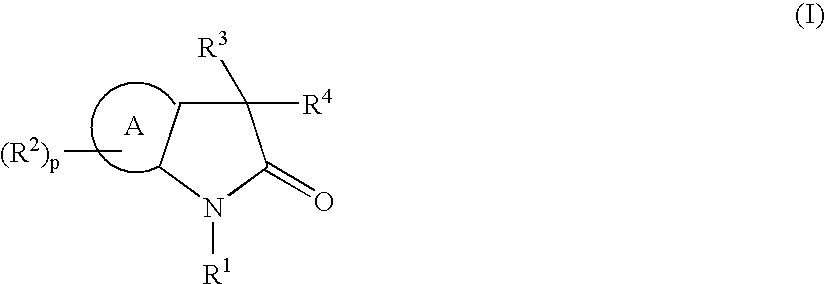Heterocyclic compounds and their uses as therapeutic agents
a technology of heterocyclic compounds and therapeutic agents, applied in the field of heterocyclic compounds, can solve the problems of major pathophysiological conditions, major changes, and insufficient potency and therapeutic index of these blockers, and achieve the effect of reducing adverse events and increasing the potency of existing or future drug therapies
- Summary
- Abstract
- Description
- Claims
- Application Information
AI Technical Summary
Benefits of technology
Problems solved by technology
Method used
Image
Examples
preparation 1
Synthesis of 1-pentyl-1H-pyrrolo[1,2-b]pyrazole-2,3-dione
A. Synthesis of N-[(1E)-pentylidene]-1H-pyrrol-1-amine
[0396] A mixture of 1H-pyrrol-1-amine (4.0 g, 49.0 mmol), valeraldehyde (4.10 g, 49.0 mmol) and molecular sieves (4 Å) in ethanol (30.0 mL) was stirred at ambient temperature overnight. The reaction mixture was filtered and the filtrate was concentrated under reduced pressure to dryness to give the title compound (unstable): MS (ES+) m / z 151.2 (M+1).
B. Synthesis of N-pentyl-1H-pyrrol-1-amine
[0397] To a solution of N-[(1E)-pentylidene]-1H-pyrrol-1-amine in THF (100 mL) was added LiAlH4 (3.80 g, 100 mmol) in small portions. The reaction mixture was stirred at ambient temperature for 20 h and quenched with the addition of saturated sodium sulfate solution dropwise. The mixture was filtered through celite, and the filtrate was concentrated under reduced pressure. The residue was subjected to column chromatography to afford the title compound (3.65 g, 51%): MS (ES+) m / z 15...
preparation 2
Synthesis of 6-pentyl-4H-thieno[2,3-b]pyrrole-4,5(6H)-dione
A. Synthesis of N-pentylthiophen-2-amine
[0399] A mixture of 2-iodothiophene (21.0 g, 100 mmol), n-pentylamine (13.5 g, 150 mmol), Cu metal (0.64 g), K3PO4 (42.4 9, 200 mmol) and water (3.60 g) in 2-(dimethylamino)ethanol (100 mL) was heated at 60° C. for 16 hours. The reaction mixture was poured into water and extracted with ether. The ether layer was separated, washed with brine, dried over anhydrous sodium sulfate and filtered. The filtrate was concentrated in vacuo to dryness to give the title compound (8.90 g, 53%): MS (ES+) m / z 170.3 (M+1).
B. Synthesis of 6-pentyl-4H-thieno[2,3-b]pyrrole-4,5(6H)-dione
[0400] A mixture of N-pentylthiophen-2-amine (8.90 g, 53.0 mmol) and oxalyl chloride (11.0 g, 87.0 mmol) in chloroform (200 mL) was heated at 60° C. for 5 hours. The reaction mixture was washed with water, brine, dried over anhydrous sodium sulfate and filtered. The filtrate was concentrated in vacuo to dryness. The r...
preparation 3
Synthesis of 4-pentyl-4H-thieno[3,2-b]pyrrole-5,6-dione
A. Synthesis of N-3-thienylpentanamide
[0401] To a solution of thiophen-3-amine (Galvez, C., et al, J. Heterocycl. Chem. (1984), 21:393-5) (5.70 g, 57.0 mmol) and triethylamine (5.82 g, 58.0 mmol) in dichloromethane (100 mL) was added pentanoyl chloride (6.93 g, 57.0 mmol) dropwise at 0° C. The reaction mixture was stirred at ambient temperature overnight and quenched with water (50.0 mL). The organic layer was dried over anhydrous sodium sulfate and filtered. The filtrate was concentrated in vacuo to dryness to afford the title compound: MS (ES+) m / z 184.3 (M+1).
B. Synthesis of N-pentylthiophen-3-amine
[0402] To a solution of N-3-thienylpentanamide (13.4 g, 73.0 mmol) in THF (200 mL) was added LiAlH4 (3.50 g, 100 mmol) at ambient temperature. The resulting mixture was stirred at ambient temperature for 16 h and at 60° C. for 1 h. After cooling down to ambient temperature, the reaction was quenched by the addition of saturat...
PUM
| Property | Measurement | Unit |
|---|---|---|
| body weight | aaaaa | aaaaa |
| body weight | aaaaa | aaaaa |
| body weight | aaaaa | aaaaa |
Abstract
Description
Claims
Application Information
 Login to View More
Login to View More - R&D
- Intellectual Property
- Life Sciences
- Materials
- Tech Scout
- Unparalleled Data Quality
- Higher Quality Content
- 60% Fewer Hallucinations
Browse by: Latest US Patents, China's latest patents, Technical Efficacy Thesaurus, Application Domain, Technology Topic, Popular Technical Reports.
© 2025 PatSnap. All rights reserved.Legal|Privacy policy|Modern Slavery Act Transparency Statement|Sitemap|About US| Contact US: help@patsnap.com



